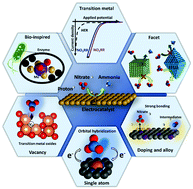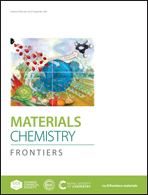Material strategies in the electrochemical nitrate reduction reaction to ammonia production
Abstract
Artificial nitrogen fixation causes excess nitrate (NO3−) production due to an unbalanced nitrogen cycle. Recently, the electrocatalytic nitrate reduction reaction (NO3RR) used to produce value-added chemicals such as ammonia (NH3) has attracted attention as a promising technology for energy and environmental reasons; however, the design of the catalytic material used in this reaction is yet to be fully understood for the production of NH3. Herein, the fundamentals of the NO3RR are introduced to understand the thermodynamics and kinetics of the NO3RR using heterogeneous electrocatalysts, and the analytical methods are explained to provide a precise evaluation of the NO3RR performance. The recent strategies used to design efficient and selective electrocatalysts have been reviewed, including the effects of facets, heterogeneous interfaces, alloying, strain, oxygen vacancies in metal oxides, single atom catalysts, and bio-inspired structures. The critical factors determining the NO3RR activity and selectivity are highlighted in terms of the nitrate adsorption, intermediate nitrite conversion, chemical environment, and intermediate species adsorption upon modifying the electronic and chemical states of the catalyst surface. The NO3RR is potentially applied for the electrochemical synthesis of nitrogen-containing chemicals.

- This article is part of the themed collections: Functional materials for sustainable future - Vision from Korean scientists and 2021 Materials Chemistry Frontiers Review-type Articles


 Please wait while we load your content...
Please wait while we load your content...